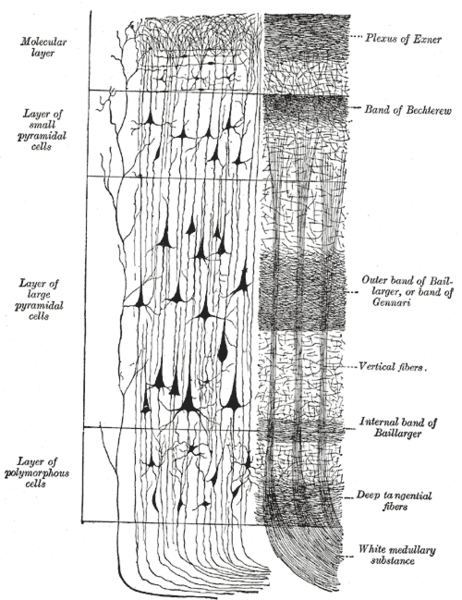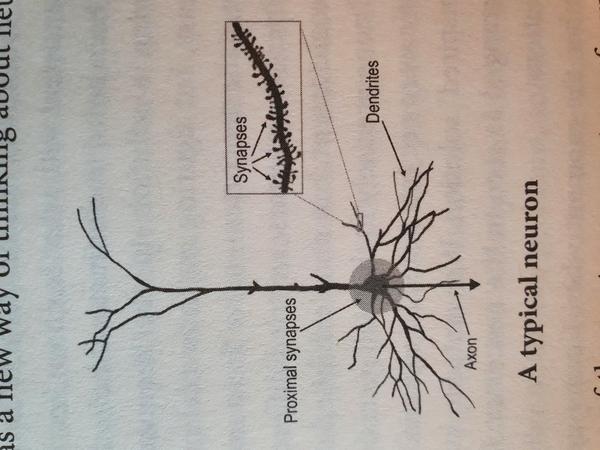Books - Read and Enjoyed
A Thousand Brains
A New Theory of Intelligence
Jeff Hawkins
Basic Books, 2021

The books consists of three parts. In part 1, a theory of the workings of the neocortex is presented and how it gives rise to intelligence. Part 2 covers artificial intelligence and is a contribution to the discussion about the dangers and promises of AI. Part 3 is the author’s personal view on humanities situation in the Galaxy, what we should do and how we should plan our future.
Jeff Hawkins is a theoretical neuroscience researcher trying to understand the architecture and mechanisms of the human brain. He has founded Numenta where he leads an effort to understand the workings of the human brain and model it in software.
The proposed theory focuses on the architecture and function of the neocortex, not the allocortex, the evolutionary older part of the brain. The neocortex is a 6-layer sheet of neurons, 2.5 mm thick and 150 cm2 large, roughly the size of an A4 sheet of paper. Although its functions vary widely including motor control, sensor data processing, language comprehension and generation, planning and, most likely, consciousness, its structure is surprisingly uniform. There are six layers populated with partly different types of neuronal cells. Most, but not all neuro-scientists, structure the neocortex in terms of columns. Each column is 0.5-1mm in diameter and extends all six layers. There are 150 000 columns forming the neocortex.

Because of the uniformity of structure neuro-scientists have long speculated that there is only one general algorithm implemented by each column. The various functions of the neocortex are realized by the interconnect structure and the different types of input data processed. The visual cortex operates in exactly the same way as the auditory cortex and the motor cortex. The visual cortex gives rise to vision because it is connected to the eye and the auditory cortex gives rise to hearing because it receives data from the ears. Vernon Mountcastle has proposed this idea in 1978, but he had no idea what the algorithm of the cortical columns might be. Although we know today many more details about neurons and the brain, we still do not know, how the cortical column algorithm might work. Jeff Hawkins’ theory proposes a framework to understand this algorithm.
Prediction
Today most neuro-scientists agree that prediction is a major part of the brains activities, see for instance The Predictive Mind by Jakob Hohwy. Some even claim, prediction is about the only thing that the brain does. Everyone can easily see for themselves, that prediction is continuously going on in one’s brain and that it is part of every perception and action. When you walk about in your apartment your vision, your hearing and your tactile systems continuously predict what will be perceived next. When you look around in a familiar room and everything is as usual, you will hardly notice and you can follow other trains of thoughts. But if any of the dozens or hundreds of objects, such as a vase, a book, a pencil, or the fingers of a clock has an unusual color, say blue instead of brown, you will immediately notice and your attention will be drawn to that unexpected feature. If your hand touches the handle of the door to open it, you may not have to even look at it, but your tactile system predicts what the hand will feel, where the handle is, how it is formed, and how it will react to the force of your hand. If just about any detail is unusual the predictive brain will detect the difference between prediction and observation and you will immediately notice. If the handle is too cold or too warm, if its form has changed, if it has a textile surface instead of metallic, if it is harder or easier to move than usually, you will notice.
We know that prediction is prevalent in the entire sensory-motor system of the brain and that it prominently features also in higher level activities like social interactions and thought experiments. But we do not know exactly how it works, and which neurons do it.

Jeff Hawkins theorizes that prediction occurs in the cortical columns inside neurons. As seen in the picture to the left, proximal synapses are located close to the cell body. When enough of them get activated, an electric spike will be generated and travel along the axon to other neurons. However, 90% of all synapses are not proximal and close to the cell body but further away on dendrites. They are called distal synapses. When they get activated, a spike along the dendrite will be generated, but it is generally too weak to trigger a spike in the axon. This constitutes a puzzle because it means that 90% if the synapses in the brain generated an activity that does not lead to the firing of the neuron along the axon. What use does it have?
Jeff Hawkins suggests that distal synapses provide a prediction and prime the neuron. If the observation then arrives on the proximal synapses, the primed neuron fires faster and earlier than it otherwise would. This means that neurons for which prediction and observation agree fire slightly earlier than neurons that observe something that has not been predicted. This time difference signals novel, unexpected information that can be used for learning and for steering the attention system.
This would indeed be a neat mechanism that explains how prediction is integrated into all normal operations of neurons. To my knowledge it is not yet widely accepted in the neuro-scientific community which may still take some time because the collection of experimental evidence for such a theory may turn out to be difficult and time consuming.
Localisation and movement
In 2005 May-Britt Moser and Edvard Moser at the Norwegian University of Science and Technology (NTNU) discovered grid cells and place cells in the entorhinal cortex of rats. In 2014 they were awarded the Nobel Prize for their discovery. Since then neuro-scientists have learned a lot about grid and space cells in many animals including humans. Grid cells represent space and the position of the animal in the space. They allow animals to efficiently navigate through space and to know where in a room and where relative to other objects it is. Place cells represent what objects are at particular places. Grid and place cells together represent the environment and the relative location of the animal within the environment.
Grid and place cells are located in the entorhinal cortex close to the hippocampus in the allocortex. Jeff Hawkins hypotheses that grid and place cells are also prevalent in the neocortex to provide information about the structures of objects and their relative positions. The idea is that all objects that we perceive are represented by systems of grid and place cells in the neocortex. For instance a coffee cup consists of different parts like handle, lip, bottom, surface, decoration, etc. The position and extension of the cup is represented by a reference frame of grid cells. All individual parts have their own reference frame. The relations between those reference frames determine the structure of the cup and its parts. Reference frames can be moved relative to other reference frames representing motion of objects relative to and within other objects represented also by reference frames.
The theory is appealing because it neatly explains our sense of space and motion, and how we can perceive objects as composed of other objects but also as units in their own right. Jeff Hawkins postulates that grid and place cells, or their equivalent, are in each cortical column throughout the neocortex and he locates them in layers 5 and 6 of each column.
Model building
Putting grid and place cells, reference frames, prediction and cortical columns together gives a theory of how the brain builds and maintains a model of the world. The reference frames based on grid cells represent the space and relative positions and movements of objects, including the animal itself. Place cells represent what objects are present at a location. Prediction facilitates the learning about the space and its content by means of motion. Whenever an object moves, or the animal moves by activating its muscles, the prediction system predicts the change of observation. In the beginning most predictions will go wrong, but gradually the predictions become better and better and thus the brain learns a model of the world.
Grid cells in the neocortex can also represent abstract spaces, like abstract concepts and ideas, and their relation to each other. The way we think about abstract concepts such as democracy, they have a structure and relation to other concepts. E.g. democracy is built up of other concepts like voting, election days, parliaments, governments, citizens and so on. All these concepts can be represented by place cells and their relations to each other by grid cells. In this way the universal algorithm of the neocortex is based on prediction and model building by representing concrete and abstract objects in 3-dimensional or more abstract spaces. The cortical column is the unit to represent objects.
For instance the visual system in the human brain is a rather complex system of interconnected modules. When a visual scene is captured by the eye and the image information enters the visual system in the brain, several dozens of modules, located in different parts of the neocortex, process parts of the information. Some columns perceive only small fractions of the image while other columns receive integrated data from large portions or the whole image. Depending on location and size of an object within the image some columns have the possibility to recognize an object, like a coffee cup. Columns that recognize objects that they have learned earlier in their lives, will become active and announce their findings. The collective activity of all active columns represent then the visualized scenery.
The proposed theory is certainly exciting and inspiring. Many of its
aspects are plausible, but it will take time until experimental
evidence has been collected to confirm or disprove them, and it will
even take more time
until a consensus forms within the scientific community.
Parts 2 and 3 of the book are also inspiring and interesting to read,
but they are more philosophical. While part one is informed by solid
and comprehensive knowledge about neuro-science, in the other parts
Jeff Hawkins drifts off to areas where his knowledge is less intimate
and profound. For instance, in part 2 he claims that artificial
intelligence is just another tool and agents with general artificial
intelligence will simply be very smart but will have no goals or
interests of their own. I think this view is a bit naive and truly
general AI will include, by necessity, a complex, hierarchical structure
of goals, values and preferences. I suspect, Jeff Hawkins
underestimates the complications and implications this will mean for
us and our coexistence with them.
Jeff Hawkins is a vivid and inspiring writer and, obviously driven by a relentless curiosity to understand human intelligence, the book gives an insight into the state of the art of neuro-science that that is otherwise rare to obtain for laypersons.
(AJ April 2022)
